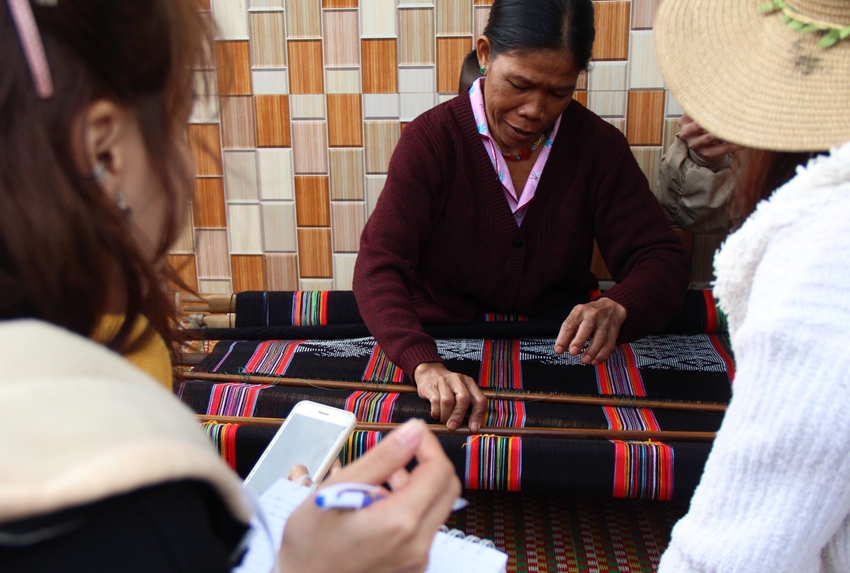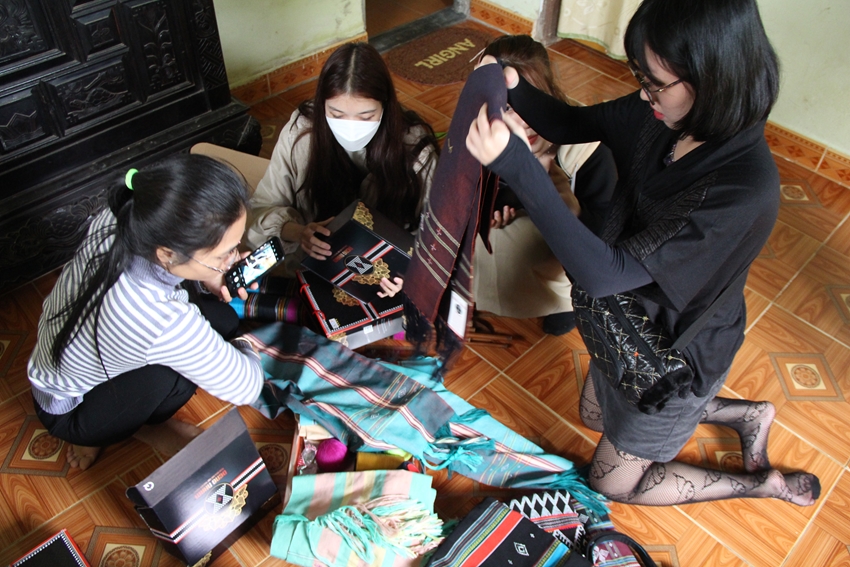    |
 |
| University students from Ho Chi Minh City travel a long distance to the mountainous district of A Luoi to learn more about Zeng, fabric made by the Ta Oi ethnic group |
Among visitors to A Luoi to learn about Zeng, there are many young people. They find Zeng more than fabric, but tradition, culture, life and beauty of weavers.
From the South to Hue for Zeng
One day in late February, more than 50 students from Van Lang University (Ho Chi Minh City) came to Hue and got together at Hue Railway Station to depart for A Luoi. They would arrive at a famous Zeng-making site of the mountainous district, at the foot of the majestic Truong Son Mountain range, called A Huor village, Quang Nham commune.
About two hours of travel through many zigzag passes and slopes, they caught sight of A Huor villagers sitting by the porch and weaving Zeng. The image really dispelled the fatigue in each young person.
Ha My, a third-year student of Fashion Design (Faculty of Fine Arts and Design, Van Lang University) said in excitement: “I’ve heard and read about Zeng quite a lot through mass media. I’ve also owned Zeng products, but right now I can see with my own eyes how the aunties weave each piece of Zeng.”
Ha My carefully observed every detail and the nimble hands of the artisan manipulating the loom. What surprised Ha My was probably the way beads were skillfully attached, making a highlight for Zeng products.
Ha My admired: “When I hold Zeng in my hand, I find that the beads have created beautiful patterns. And when I see the process of beading and creating patterns and textures, I understand that it has been really labor-intensive and time-consuming process.”
Like Ha My, her classmates went from surprise to excitement. Not only patterns on Zeng, but also products such as scarves, bags made of Zeng with modern patterns have been skillfully modified and styled by Ta Oi artisans in A Luoi.
“The artisans here not only preserve the culture and local identity but also know how to style and keep up with modern fashion trends,” many students had the same opinion when they were introduced to many products that have been available on the market.
    |
 |
| Beaded patterns are the most impressive on products made of Zeng |
Amidst the laughter and laughter, Thu Thao, a student in the group, asked to take a picture of an old lady in an outfit made of Zeng with many beads and patterns. Thao also meticulously took close-ups of every detail.
It was found out later that the outfit was hand-woven by the old lady’s daughter for her. It is believed that the more beads on Zeng products, the more beads luxury and more affection of the giver they display.
“I was also told that costumes like that are only worn for important events and festivals in the village, or during the event of welcoming visitors to the village and learn about Zeng costumes,” Thu Thao said.
    |
 |
| Young people taking photos of a scarf made of Zeng |
Zeng not only attracts researchers and cultural experts, but it has attracted young people passionate about exploring traditional values in recent years.
For more love of traditional culture
Not only did the young learn about Zeng on site, but they also were provided with much interesting information by experienced experts and researchers from the Vietnam Sub-Institute of Culture and Arts in Hue.
It includes an overview of the Ta Oi people in Vietnam and in A Luoi as well as their cultural features: from village organization, social organization, farming life, customs and habits, human life cycle, and cuisine, to their folk-art repertoire.
Nguyen Phuoc Bao Dan, researcher, (Vietnam Sub-Institute of Culture and Arts in Hue) said that young people from Ho Chi Minh City were careful in observing, recording, photographing and filming what they witness.
According to Bao Dan, taking students to fieldtrips not only helps them understand Zeng, but also helps promote Zeng products of the Ta Oi people as a typical part of weaving with primitive techniques that has been preserved in the mountainous area of the Northern Central region.
    |
 |
| Zeng has recently become a brand name and upgraded in response to the production of many trendy innovative models |
“From the perspective of the fashion design industry, Zeng has always brought about an attraction. This is the inherent magnet of a type of textile product containing pristine beauty, in addition to the discovery and experiment of new materials in fashion design,” said Bao Dan. He also said that the students’ exposure to Zeng was not only interesting but also promising for both sides.
Mr. Phan Quan Dung, Head of the Department of Fine Arts and Design, Van Lang University, who led students to Hue to learn Zeng, said that art schools once forgot about traditional cultural and artistic forms. It is not until recently that attention has been paid to these forms of art by schools.
“On our part, we have contacted with the Vietnam Sub-Institute of Culture and Arts in Hue since 2012 to take students to Hue for fieldtrips and explore the traditional art and culture, including Zen weaving in A Luoi,” said Mr. Dung.
These fieldtrips, according to Mr. Dung, have warmed up the hope that this approach helps students understand and love more of the traditional Vietnamese culture in general and Hue, especially A Luoi’s Zeng weaving, in particular.
Dr. Le Anh Tuan, Deputy Director of the Vietnam Sub-Institute of Culture and Arts in Hue, said that it is not simple to preserve the identity of traditional craft, and at the same time satisfying needs of modern life.
It is hoped that the exchanges between fashion students and artisans of traditional products like Zeng will open up opportunities for promoting and creating modern products, as well as supporting each other to preserve cultural values.
“The students not only study but also accompany the locals to help them diversify their products, helping them preserve their traditional jobs and make livings from them,” said Dr. Le Anh Tuan.